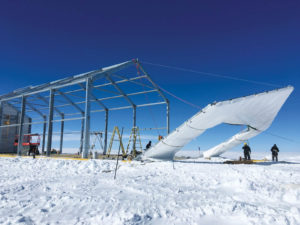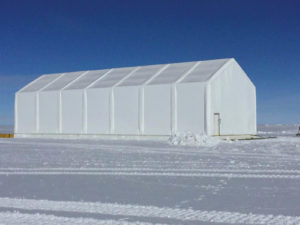
A modular structure recently installed at the Summit Station, Greenland, meets the unique needs of the extreme cold weather location through a design by Rubb USA and fabric from Serge Ferrari.
The Summit Station, located on the summit of the Greenland ice sheet, is home to the National Science Foundation’s Greenland Environmental Observatory (GEOSummit). The station is atop almost two miles of ice and is nearly 245 miles from the nearest point of land. It supports a variety of scientific research, including ongoing research of the rapidly melting Greenland ice sheet and its impact on rising sea levels and sea life.
Life at the Summit Station has many challenges. Temperatures range from a high of 14 degrees Fahrenheit in summer to a low of -49 degrees Fahrenheit in winter, with temperatures logged as low as -100 degrees Fahrenheit. Up to 120 inches of snow fall per year, causing any structure erected at the site to be buried due to drifting snow.
The National Science Foundation and its operations partner, CH2M Hill Polar Services, hired Rubb USA to provide a relocatable equipment and maintenance storage facility. Rubb designed a structure that could be built on-site and was durable enough to withstand the elements yet light enough, and on a sled platform, to be moved by tractor out of the burying snow.
The 32-by-97-foot structure was designed, pre-fabricated and test-erected at Rubb’s Sanford, Maine, facility, then delivered to the site by a military airplane. The installation took only a month despite extreme site conditions and minimal equipment.
 The insulated double-wall construction is supported by a steel frame. Serge Ferrari’s Precontraint 932 S2 was installed as the exterior wall due to its low temperature resistance (-60 degrees Fahrenheit), and Serge Ferrari’s Precontraint 412, a light-blocking material, was installed as the interior wall. An 8-inch-thick insulating blanket, Rubb Thermohall®, was installed in the pocket between the Serge Ferrari walls to keep the interior from freezing. A generator-driven lighting and heating system was also installed.
The insulated double-wall construction is supported by a steel frame. Serge Ferrari’s Precontraint 932 S2 was installed as the exterior wall due to its low temperature resistance (-60 degrees Fahrenheit), and Serge Ferrari’s Precontraint 412, a light-blocking material, was installed as the interior wall. An 8-inch-thick insulating blanket, Rubb Thermohall®, was installed in the pocket between the Serge Ferrari walls to keep the interior from freezing. A generator-driven lighting and heating system was also installed.
A project of this scope and in these conditions can provide many challenges, immediately testing the durability of both the design and the materials. Just the pulling of the Serge Ferrari material over the steel frame in freezing conditions is enough to test the strength and low temperature resistance of the material. After the installation was complete, the structure was test-moved some 1,200 feet. In both instances, no tears or other damage were reported.
 TEXTILES.ORG
TEXTILES.ORG


